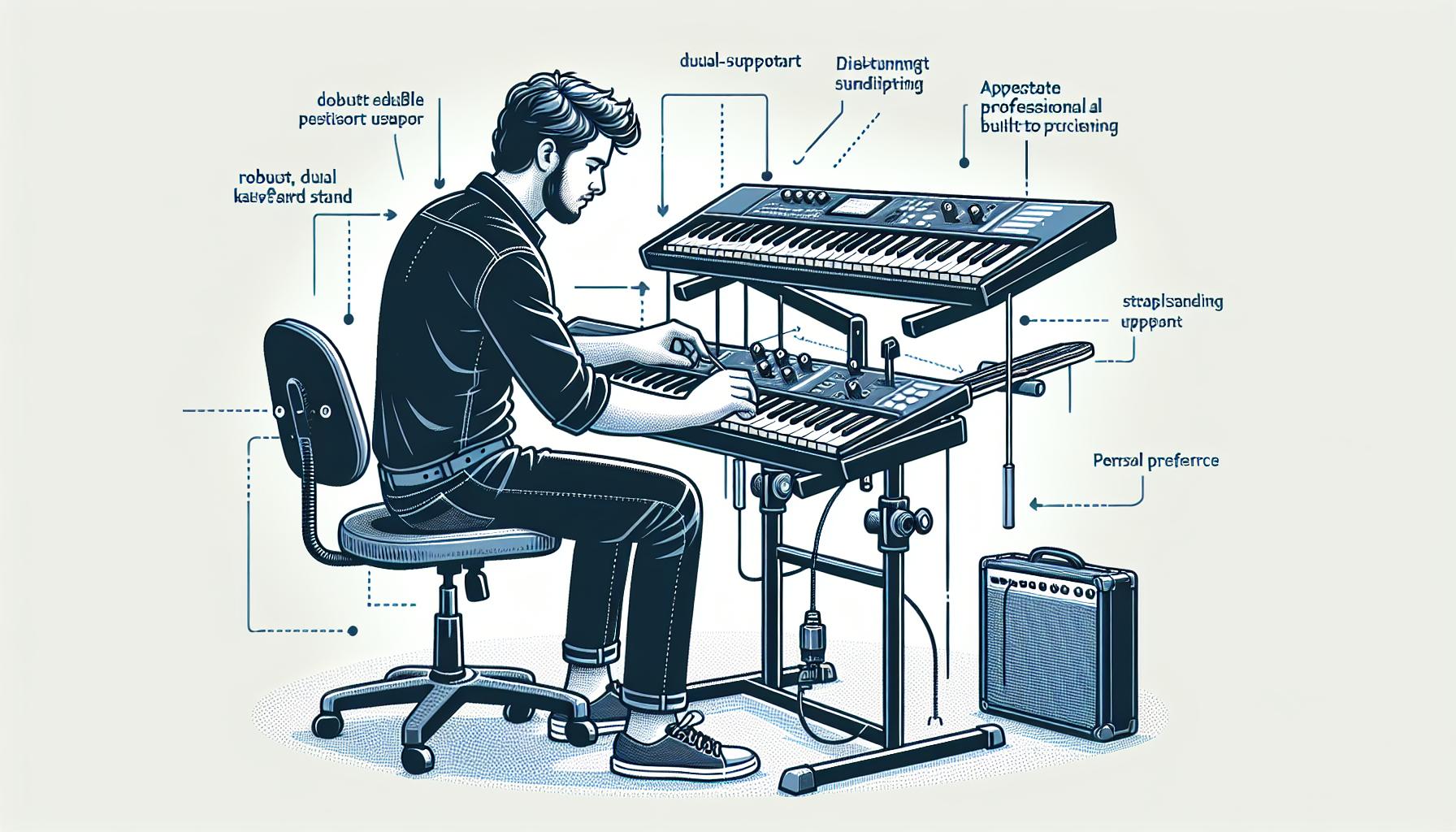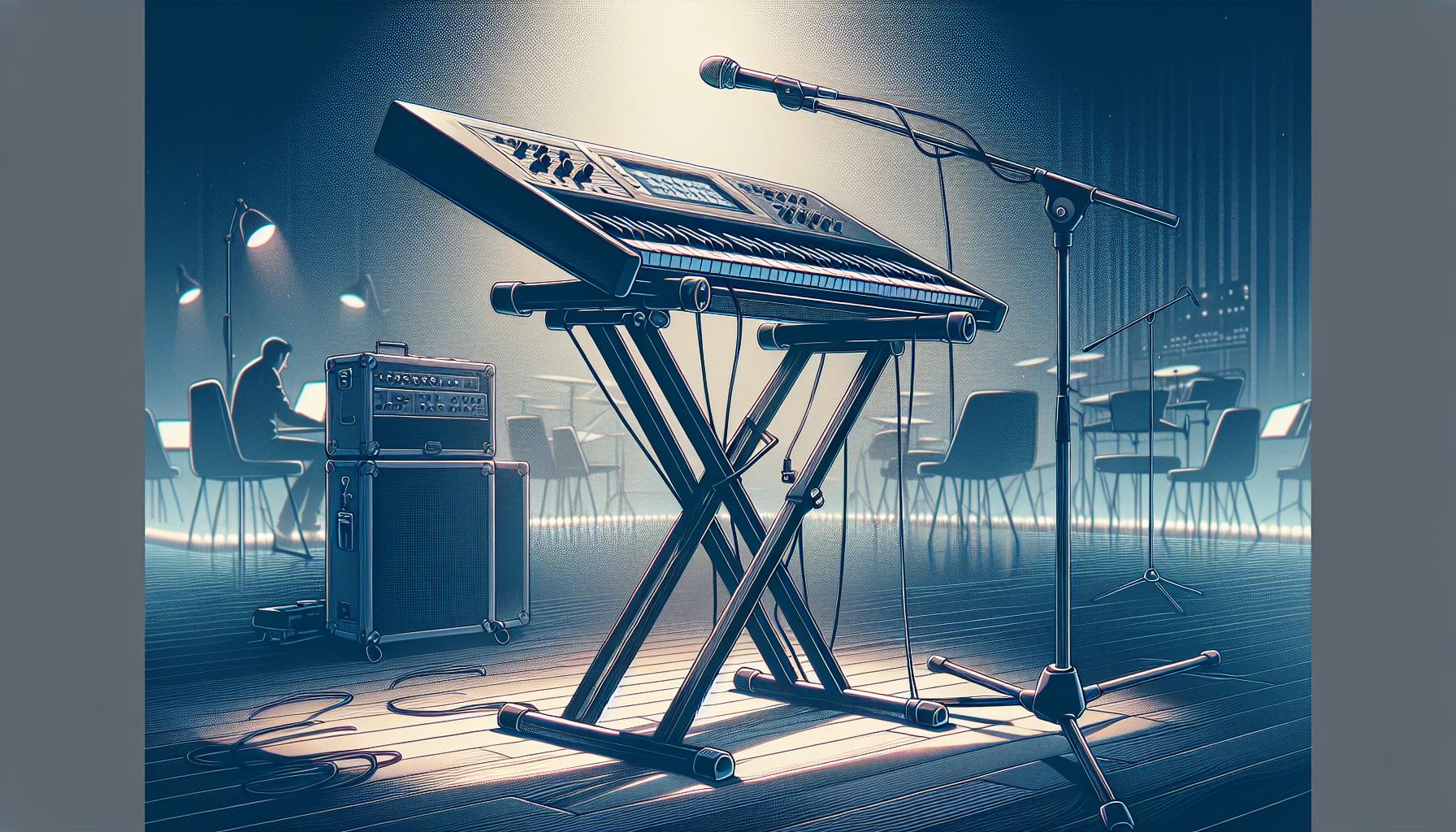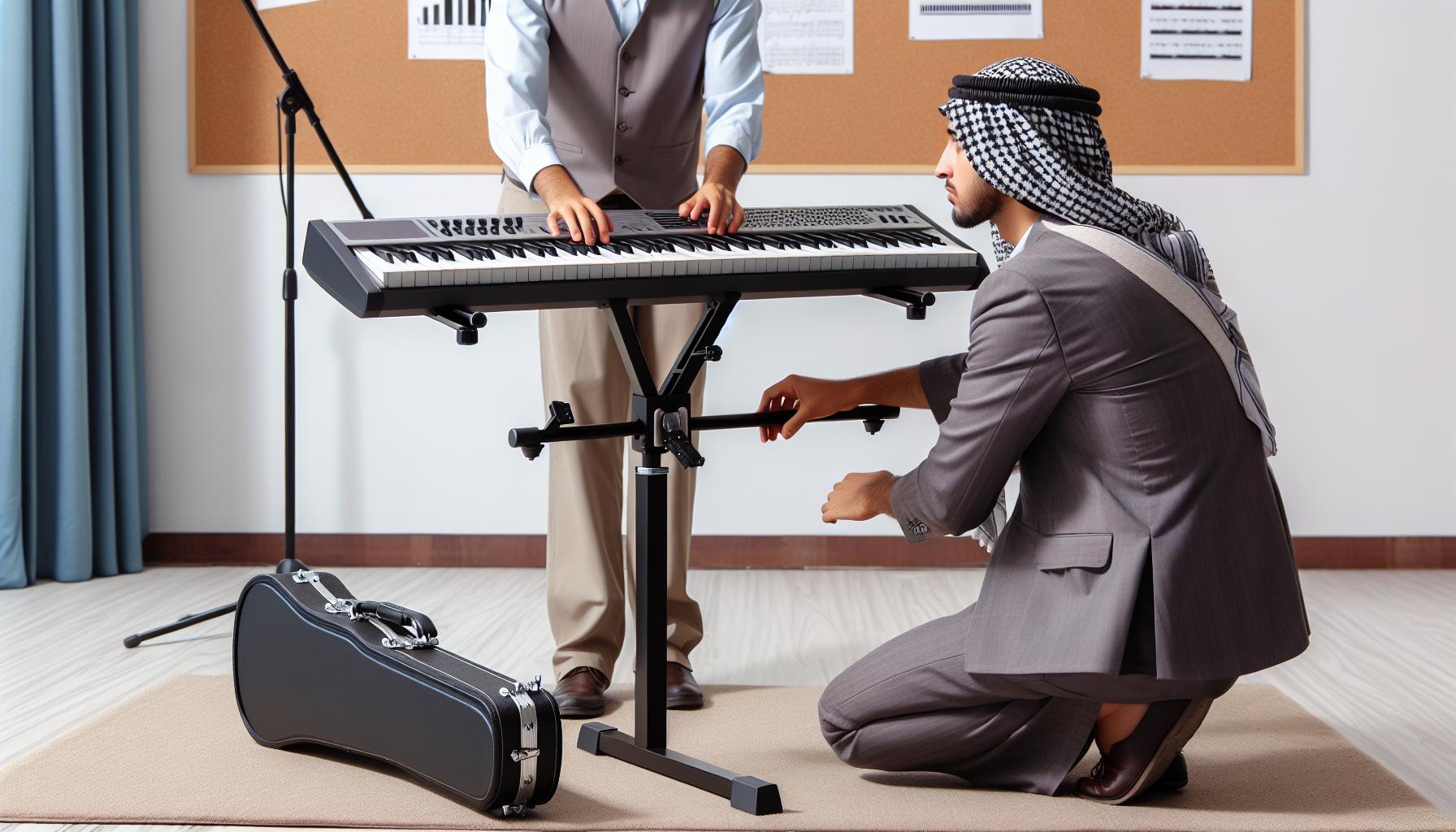Stepping into the world of music is exciting, and having the right gear can make all the difference. For beginners, finding the perfect keyboard stand is crucial. It's not just about having something to hold your keyboard; it's about comfort, stability, and making your practice sessions as productive as they can be.
With so many options out there, it can be overwhelming to choose the right one. But fear not! Whether you're looking for something budget-friendly, portable, or with specific features, there's a keyboard stand out there that's perfect for you. Let's dive into what makes a keyboard stand great for beginners and how it can elevate your musical journey.
Importance of a Keyboard Stand for Beginners
When diving into the world of music, beginners may not initially understand the importance of a good keyboard stand. It's not just an accessory; it's a critical component of the learning experience. A well-chosen stand can significantly impact comfort, stability, and overall practice quality.
Firstly, comfort is paramount when learning a new instrument. An adjustable stand allows beginners to set the keyboard at the perfect height, preventing strain on the back, neck, and wrists. This adjustment is crucial, as playing in an uncomfortable position can lead to poor technique and even injury over time. Ergonomics play a significant role in a musician's development, and a suitable stand ensures that players can focus on their practice without discomfort.
Secondly, stability is another non-negotiable feature of a quality keyboard stand. Imagine trying to master a new song or practice scales on a wobbly surface. It's not only frustrating but can also inhibit progress. A stable stand gives beginners confidence, allowing them to concentrate on their music instead of worrying about their instrument's safety. The assurance that their keyboard won't topple over during a passionate practice session is priceless.
Moreover, the right keyboard stand can enhance practice sessions by accommodating additional music-making tools. Some stands come with attachments for music sheets, laptops, or even another keyboard, enabling a more seamless and productive practice environment. This flexibility supports a beginner's growth, allowing them to explore different aspects of music-making without limitations.
For beginners, the journey into music is filled with discoveries and challenges. The choice of a keyboard stand might seem minor in the grand scheme, but it's these details that lay the foundation for a fulfilling musical experience. The market offers a variety of stands, ranging from the simple and affordable to the feature-rich and premium. Key considerations include:
- Height adjustability for ergonomic playing
- Stability to prevent accidents
- Portability for musicians on the go
- Compatibility with the player's keyboard and lifestyle
| Quality | Importance |
|---|---|
| Comfort | Prevents strain and supports proper technique. |
| Stability | Ensures safety and confidence during practice. |
| Flexibility | Accommodates additional music-making tools. |
Factors to Consider When Choosing a Keyboard Stand

When embarking on the journey to find the best keyboard stand, beginners might find the array of options overwhelming. However, focusing on a few key aspects can make this task more manageable and ensure that the selected stand complements their musical journey.
Height Adjustability is paramount when selecting a keyboard stand. Everyone’s body is different, and playing in a comfortable position is crucial for both learning efficiently and preventing strain or injury. Whether sitting or standing, the ability to adjust the height of the keyboard stand can greatly impact a musician's comfort and performance. This feature allows beginners to adapt the stand as they grow and their playing style evolves.
Stability cannot be overstated. A wobbly stand can be a significant distraction and even deter a beginner from practicing. It's essential that the stand can securely hold the keyboard, ensuring it remains immovable during use. This stability fosters a safe learning environment, allowing the musician to focus solely on their practice without the fear of the instrument tipping over.
Another factor to consider is the Weight Capacity of the stand. Keyboards vary in weight, and choosing a stand that can support the weight of the particular keyboard is crucial. Overloading a stand not designed to hold a heavy keyboard can lead to accidents and potentially damage the instrument.
Portability might also be a critical aspect, especially for musicians who plan to transport their instrument to lessons, performances, or practice sessions away from home. Some stands are designed to be lightweight and foldable, making them easy to carry and store. For those who anticipate moving their keyboard regularly, investing in a portable stand is a wise choice.
Lastly, the Type of Stand needs to be considered. The market offers various designs, each with its pros and cons. X-stands are popular for their portability and affordability but may lack in stability for heavier keyboards. Z-stands offer excellent stability and space for pedal setups but can be heavier and more expensive. Double-braced stands strike a balance between stability and portability and are often a good choice for beginners.
When choosing a keyboard stand, beginners should pay attention to:
- Height Adjustability
- Stability
- Weight Capacity
- Portability
- Type of Stand
Keeping these factors in mind will help beginners find a stand that not only supports their instrument securely but also promotes a comfortable and enjoyable learning experience.
Top Budget-Friendly Keyboard Stands for Beginners

When starting out on a musical journey, beginners often look for options that are easy on the wallet without compromising on quality. Finding a keyboard stand that fits this criterion can be challenging, yet there are several budget-friendly stands out there that tick all the necessary boxes for a beginner.
X-Style Stands are a popular choice among beginners for several reasons. Not only are they affordable, but they also offer great stability and portability. Many models come with height adjustability features, making them suitable for musicians of all ages and sizes. Their compact design allows for easy storage and transport, an added bonus for those who may need to move their setup frequently.
| Model | Price Range | Key Features |
|---|---|---|
| Basic X-Style | $20 - $50 | Lightweight, height adjustable, easy to transport |
| Double-Braced X | $40 - $70 | Enhanced stability, durable, height adjustable |
Table-Style Stands are another excellent option for beginners looking for reliability at a lower cost. They offer a sturdy platform for the keyboard, reducing the risk of movement or tipping during use. Though they tend to be slightly more expensive than the X-style stands, their durability and the added surface area make them worth the extra investment for some.
| Model | Price Range | Key Features |
|---|---|---|
| Basic Table-Style | $50 - $80 | Sturdy, wide surface area, usually foldable |
| Heavy-Duty Table | $70 - $100 | Extra stability, capable of holding heavier keyboards |
In selecting a keyboard stand, beginners should consider not only the initial cost but also the stand's adaptability to their growing skills and potentially increasing keyboard size. A stand that can grow with the musician represents a better long-term investment than one that might need to be replaced as the musician's needs evolve.
It's also worthwhile to look out for stands that offer quick and easy adjustability. For young learners or those who share their instruments with other family members, being able to change the height of the keyboard stand without a hassle is a significant plus.
Portable Keyboard Stands Ideal for Beginners on the Go

For beginners who value mobility alongside their musical progression, portable keyboard stands emerge as an ideal solution. These stands are designed with the traveling musician in mind, ensuring that mobility does not sacrifice stability and reliability. Lightweight yet sturdy, these stands make setting up and breaking down a breeze.
X-Style Portable Stands
Among the most popular portable options are the X-Style Stands. Their collapsible design allows for easy transport and storage. Available in both single and double-braced versions, they cater to a range of keyboard weights. The double-braced models, in particular, offer additional stability, making them a preferred choice for heavier instruments. Many X-Style stands feature quick-release mechanisms, allowing for rapid height adjustments even during performances.
Table-Style Portable Stands
For those who seek a broader base for their setup, Table-Style Portable Stands present a fantastic alternative. Though slightly heavier than their X-Style counterparts, these stands provide unmatched surface stability, which is crucial during live performances or dynamic playing sessions. Modern designs have significantly reduced their bulk without compromising on the support they offer, ensuring they remain a top choice for performers on the move.
Key Considerations for Portable Stand Selection
When choosing a portable keyboard stand, several factors come into play:
- Weight and Portability: Lighter stands are easier to carry, but ensure they can support your keyboard's weight.
- Adjustability: Look for stands that offer easy height adjustments to accommodate different playing styles and seating arrangements.
- Stability: Opt for stands that provide a firm grip on the ground and your keyboard, especially for lively performances.
| Feature | Importance for Beginners |
|---|---|
| Weight | High |
| Portability | High |
| Adjustability | High |
| Stability | Critical |
Compatibility and Growth
It's crucial to select a stand that not only fits the beginner's current keyboard but also accommodates potential upgrades. As beginners develop their skills, they might opt for larger keyboards that demand more robust support. Portable stands that offer a range of adjustability and compatibility with different models ensure that the initial investment continues to benefit the musician's journey.
Key Features to Look for in a Keyboard Stand for Beginners

When embarking on their musical journey, beginners may find the vast array of keyboard stands daunting. However, understanding the key features to look for can streamline the selection process and ensure they get a stand that not only supports their instrument but also their growth as a musician.
Adjustability is paramount. As beginners hone their skills, they'll spend countless hours at their keyboard. An adjustable stand ensures they can maintain an ergonomic posture, preventing strain and fostering longer, more productive practice sessions. Look for stands that offer easy height and width adjustments to accommodate both the player's physical needs and different keyboard sizes.
Stability cannot be overstated. A wobbling stand can distract from practice and, in worst-case scenarios, lead to accidents. Beginners should opt for stands with a solid construction and a weight capacity that surpasses their keyboard's weight. The base's design, be it X-style or table-style, plays a crucial role. Table-style stands typically provide more surface stability, making them a safe bet for heavier keyboards or vigorous playing styles.
Portability is another vital aspect, especially for beginners who may take their keyboard to lessons or performances. Lightweight stands with a collapsible design make transportation a breeze without sacrificing stability. For those constantly on the move, quick-release mechanisms can save precious time during setup and takedown.
Lastly, compatibility with the beginner's current and potential future keyboards guarantees a lasting investment. In the fast-paced world of music technology, upgradeability is an asset. A stand that accommodates various models and sizes allows beginners to explore different keyboards without the need to purchase a new stand each time.
Weight, portability, adjustability, and stability are not mere conveniences; they are essentials that can significantly impact a beginner's learning experience. Choosing a stand that ticks all these boxes means beginners can focus on what truly matters: their music. Alongside these considerations, beginners should also weigh the stand's compatibility and potential for growth. Investing in a stand that can grow with them ensures they're not hindered by their equipment as they progress through their musical journey.
Conclusion
Choosing the right keyboard stand is a pivotal step for any beginner eager to embark on their musical journey. It's not just about having a stand; it's about finding one that grows with them, supports their posture, and ensures every practice session is as productive as possible. Remember, a stand that's adjustable, stable, portable, and compatible isn't just an accessory—it's a companion on the path to musical mastery. So take the time to pick wisely and watch as it transforms the learning experience into something truly harmonious.
Harlan Kilstein began playing piano during covid with no piano background at all. He taught himself how to play learning what to do and what not to do.
Today he's an advanced intermediate player and can help you grow in your skills because he learned all this on his own.








